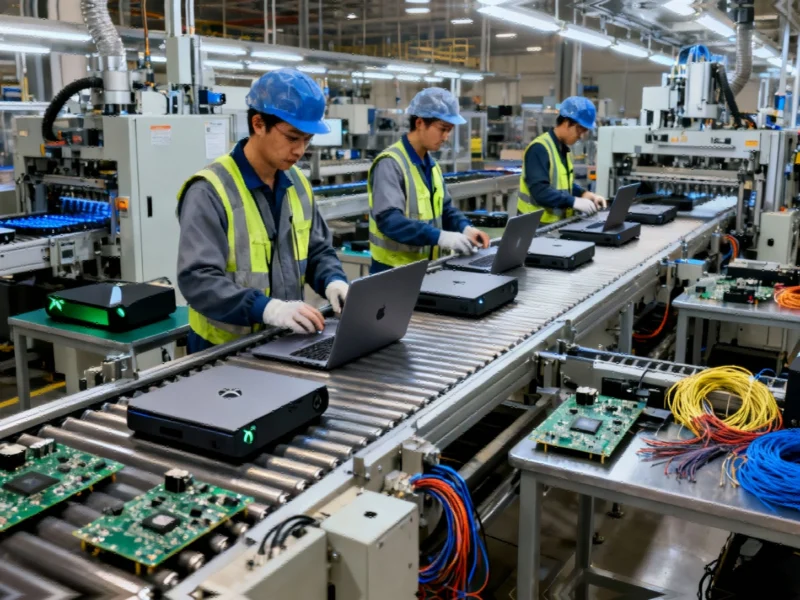Microsoft Diversifies Manufacturing Amid Geopolitical Pressures
Microsoft is reportedly initiating a significant restructuring of its hardware manufacturing operations, with plans to relocate Surface device production and potentially Xbox console manufacturing outside of China. According to sources cited by The Verge and Nikkei Asia, this strategic shift responds to escalating trade tensions between the United States and China that threaten to disrupt global supply chains and increase production costs.
Comprehensive Production Relocation Strategy
The technology giant isn’t merely moving final assembly operations – Microsoft is implementing a comprehensive supply chain transformation that includes relocating component manufacturing for fibers, cables, and circuit boards. This represents a fundamental rethinking of how the company sources and assembles its hardware products. The company aims to have new Surface devices completely manufactured outside China by 2026, building on its previous experience relocating server production facilities.
This manufacturing shift aligns with broader industry developments as numerous technology companies reassess their dependence on Chinese manufacturing infrastructure. The move could potentially insulate Microsoft from future supply chain disruptions and tariff-related cost increases that have impacted profitability across the sector.
Xbox Production Shift Could Benefit Gamers
For gaming enthusiasts who have watched console prices climb despite typical technology depreciation curves, the potential relocation of Xbox production offers hope for more stable pricing. Manufacturing cost increases, driven partially by tariffs, have contributed to the console’s rising price point in recent years. A diversified manufacturing base could help Microsoft stabilize production expenses and potentially reverse the trend of increasing hardware costs.
The gaming industry continues to navigate complex market trends affecting both hardware and software pricing. Microsoft’s potential manufacturing relocation represents a strategic response to these challenges that could benefit consumers through more predictable pricing.
Geopolitical Tensions Drive Manufacturing Decisions
The timing of Microsoft’s supply chain reassessment coincides with renewed trade tensions between Washington and Beijing. Recent threats of substantial tariff increases on Chinese goods, coupled with China’s tightening export controls on rare earth materials essential for electronics manufacturing, have created significant uncertainty for U.S. technology companies dependent on Chinese production.
These geopolitical factors are creating ripple effects across multiple sectors, including energy policy where a bipartisan energy strategy aims to address similar supply chain vulnerabilities. The interconnected nature of global manufacturing means that disruptions in one sector often impact others, prompting comprehensive strategic reassessments.
Long-term Strategic Benefits
While relocating established manufacturing operations involves significant short-term costs and logistical challenges, Microsoft’s decision reflects a calculated long-term strategy. Developing alternative manufacturing ecosystems reduces dependence on any single country’s infrastructure and political stability. This diversification could provide Microsoft with greater flexibility to navigate future trade disputes and supply chain disruptions.
The technology landscape continues to evolve rapidly, with companies investing heavily in related innovations like artificial intelligence capabilities. These advancements increasingly depend on stable hardware manufacturing to reach consumers effectively.
Broader Industry Implications
Microsoft’s manufacturing relocation could signal a broader trend among technology companies seeking to mitigate geopolitical risks. As trade tensions persist, other hardware manufacturers may follow suit, potentially reshaping global electronics manufacturing distribution over the coming decade.
This strategic shift occurs alongside other recent technology sector transformations that are redefining how companies approach production and distribution. The cumulative effect of these changes could significantly alter the competitive landscape for consumer electronics and computing devices.
For consumers, the potential benefits include more stable pricing and reduced vulnerability to trade-related supply disruptions. However, the transition period may involve temporary challenges as manufacturing operations stabilize in new locations. Microsoft’s comprehensive approach to relocating both final assembly and component manufacturing suggests the company is committed to creating a resilient supply chain capable of supporting its hardware ambitions for years to come.
This article aggregates information from publicly available sources. All trademarks and copyrights belong to their respective owners.



